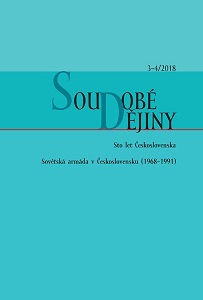Sovětská základna uprostřed Čech
The Soviet base in the middle of Bohemia
Milovice at the time of the Soviet military presence in the territory of Czechoslovakia (1968–1991)
Author(s): Prokop TomekSubject(s): History, Local History / Microhistory, Military history, Social history, Recent History (1900 till today), Post-War period (1950 - 1989), Transformation Period (1990 - 2010), History of Communism
Published by: AV ČR - Akademie věd České republiky - Ústav pro soudobé dějiny
Keywords: Czechoslovakia 1968-1989; Soviet Army; Milovice;normalisation in the Czechoslovak Socialist Republic;
Summary/Abstract: The study attempts to capture, in a comprehensive manner, various aspects associated with the presence of the Soviet military garrison in the Central Bohemian municipality of Milovice between 1968 and 1991. In doing so, it relies, to a considerable extent, on local, archival, and other sources. The author first briefly introduces the history of Milovice. Since the beginning of the 20th century, the town and its surroundings were substantially influenced by a unique military training facility in the quarter of Mladá, which was first used by the Austro-Hungarian and then successively by the Czechoslovak, German, again Czechoslovak, and finally Soviet armies. Milovice therefore constitute a unique environment which is presently undergoing a transformation from an area burdened with decrepit military buildings and environmental contamination into a dynamically developing small town. A particularly interesting chapter in its history started after August 21, 1968, when the Soviet intervention army took over the local military training area and established not only a numerous garrison, but also the Headquarters of the Central Group of Forces there. Milovice thus became not just an exclusive and strictly guarded zone, but also a political symbol of the Soviet military presence in Czechoslovakia. The author focuses mainly on the evolution of relations between local inhabitants and members of the Soviet garrison (which included not only soldiers, but also families of officers and civilian workers), as well as on changes of the local environment and everyday life and consequences of the Soviet presence during the period mentioned above. He follows protests of locals against the Soviet invasion, their resentful reactions to the establishment of the Soviet garrison, and then the progress of the so-called normalization in the region of Milovice and in the district of Nymburk, characterized by changes of attitudes of local political bodies, party vetting, establishment of contacts with the Soviet Army, and manifestation visits of state and party officials. He describes in detail the problematic security situation in Milovice, with a lot of minor criminal offences and stricter police checks, serious environmental damage, in particular water and soil contamination by oil hydrocarbons, problems of local people with the supply of drinking water, food, and hard goods (but also popular shopping sprees of locals in better-than-average stocked Soviet shops), traffic difficulties, devastation of residential and public buildings and areas often caused by disrespect of regulations and rules of coexistence on the part of Soviet citizens. However, he also describes informal contacts of locals with the Soviet garrison, frequently for the purpose of illegal barter trade in goods in short supply, taking place in parallel to official manifestations of the Czechoslovak-Soviet “friendship”. Complaints of local people about a variety of problems were a permanent phenomenon accompanying the Soviet presence; however, the powers-that-be dealt with them only formally, or not at all, and all efforts to seek remedy were useless.
Journal: Soudobé Dějiny
- Issue Year: XXV/2018
- Issue No: 3+4
- Page Range: 433-488
- Page Count: 56
- Language: Czech

